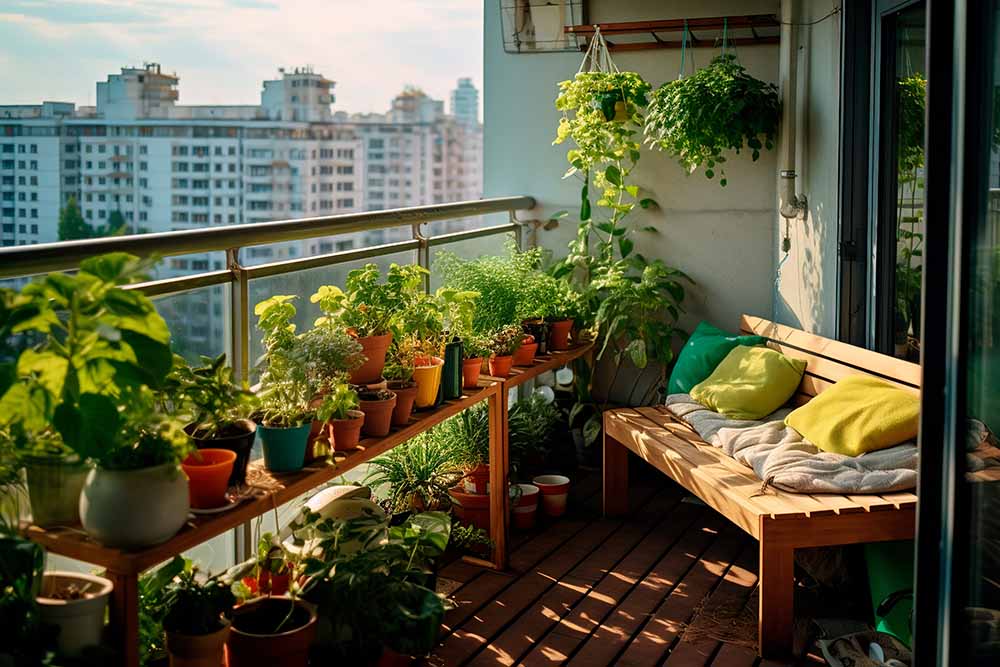
A lush garden filled with flowers, perennials, and vegetables isn’t limited to homes with big backyards. While apartment or condo balconies offer less surface area to work with, they can still provide plenty of space for good things to grow. Balcony gardening may not allow you to grow the same quantity of fresh veggies or as many varieties of plants as a plot of earth, but you might be surprised at what’s possible with a little know-how and planning. Grab your watering can and read on for everything you’ll need to get started.
Evaluate your space Check your exposure Water is life Start small Sun or shade? Bring the buzz Maximize your space Essential maintenance
Evaluate your space
Like every great garden, your balcony garden should start with an assessment of the area to determine what’s possible. The first thing an aspiring balcony gardener should do is check their building’s rules and see what limits (if any) it places on pots and containers. From aesthetic codes about what can and can’t be visible from the street to the structural weight limit of your balcony, buildings have a wide variety of rules about what you can do, and it’s advisable to be aware of them before you get to work.
Check your exposure
Once you’ve determined the type of garden that’s allowed, it’s time to consider what’s possible given your climate zone and the weather conditions of your unit. A south-facing balcony, for example, will allow you to grow flowers and veggies that wouldn’t get enough sun in a north-facing one. Prevailing winds are also worth taking into account, as they can dry out or damage your plants.
Water is life
If your balcony is covered, you’ll need to provide your garden with most of the water it needs. What’s your best and closest water source? If it’s the kitchen sink, make sure you’re able and willing to lug heavy watering cans out to your garden every day. Gardens need a surprising amount of water, and containers tend to dry out faster than garden beds, especially in the hot summer months. Likewise, be sure to place all of your pots and containers on a deep tray or dish to keep any overflow from dripping on neighbours or passersby below, or choose self-watering containers.
Start small
Gardening is all about trial and error, and you’ll likely have plenty of failures as well as successes. Gardening can also be time intensive, and the cost of pots, plants, soil, and gardening tools can add up fast, so the easiest (and most budget-friendly) strategy is to start small and grow your plant family a little more each year.
Sun or shade?
If you aspire to grow vegetables like tomatoes and green beans, you’ll need a balcony that gets at least six to eight hours of direct sun each day. If your garden is in a shadier spot, you’ll have better success with herbs like thyme and basil, as well as lettuces, which tend to be hardier and more forgiving than other types of veggies. For flowers, sun-loving species include hydrangeas and petunias, while lavender and ferns can thrive in shadier areas.
Bring the buzz
Pollinator species like bees and butterflies are vital to most ecosystems, and they are increasingly threatened by habitat loss and pesticide use. Whatever you plant, be sure to make room for pollinator-friendly species like bee balm, echinacea, and native wildflowers.
Maximize your space
Once you’re ready to grow, you might be surprised at how much greenery your little balcony can accommodate. For very small spaces, trellises placed against walls are a way to make use of vertical space, both for hanging pots and climbing vines. Window boxes, tables, benches, and plant stands are also essential tools for balcony gardeners, as they allow you to arrange your garden in tiers, with the tallest (or dangliest) plants in the back, and the lower-lying ones in front.
Essential maintenance
All any garden needs to thrive is soil, sun, and water, but there are a few other things you can do to keep your plants happy. For flowers, regular “deadheading” (pinching or snipping off the dead flowers) will encourage new ones to grow. Container-grown plants also have less access to nutrients compared to those grown in the ground, so an occasional dose of liquid fertilizer (usually mixed into your watering can) can help them stay happy all season long.
Jeremy Freed is a freelance writer and editor based in Toronto. His writing about fashion, travel, food and design appears in Sharp, Harry and re:Porter magazines, among many others.